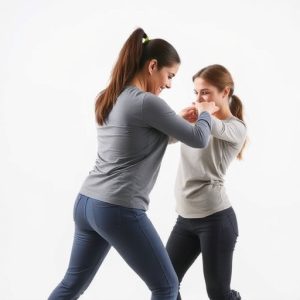Empower Yourself: Essential Self-Defense Tips for Women’s Safety
Self-defense for women is a multifaceted approach that goes beyond physical techniques to encompass…….
Self-defense for women is a multifaceted approach that goes beyond physical techniques to encompass heightened situational awareness, preventative measures, and personal empowerment. It involves staying vigilant, recognizing potential threats through body language, verbal signals, and contextual cues, and employing life skills like confident assertiveness and maintaining fitness for quick reactions. Knowledge of local self-defense laws is crucial to understand one's legal rights, and self-defense for women tips often include mastering escape routes, using safety devices like pepper spray or whistles, and transforming everyday objects into makeshift weapons. Specialized classes tailored for women are recommended to practice these skills effectively. Pepper spray, as a non-lethal deterrent, is a practical choice due to its effectiveness in disabling an attacker and the presence of UV marking dye to aid law enforcement. Personal alarm systems also serve as audible deterrents. Understanding self-defense laws, accessing support services, and utilizing educational resources from women's centers and victim advocacy groups are key components of a comprehensive personal safety strategy for women. By integrating these practices and tools into daily life, women can significantly enhance their ability to protect themselves in threatening situations.
When it comes to personal safety, self-defense for women is a critical skill that transcends physical strength. This article provides comprehensive guidance on empowering women through awareness, preventive strategies, and legal support. From mastering essential self-defense moves to understanding the intricacies of self-defense laws, readers will gain valuable insights into personal safety tools like pepper spray and alarm systems. Each section is crafted to offer practical tips and resources for a safer, more confident daily life.
Understanding Self-Defense: Empowerment through Awareness and Prevention Strategies for Women
Understanding self-defense is not merely about learning physical techniques to fend off an attacker; it’s a multifaceted approach that includes awareness, prevention strategies, and empowerment. Women can enhance their personal safety by being vigilant and aware of their surroundings. This proactive mindset involves recognizing potential hazards in various settings, from well-lit urban streets to isolated areas. By staying alert and being conscious of one’s environment, women can often prevent situations from escalating into confrontations or attacks.
Self-defense for women tips extend beyond physical self-defense techniques; they encompass practical life skills. These include learning how to identify potentially dangerous situations, understanding body language and verbal cues that may precede an attack, and knowing how to assert oneself confidently. Effective self-defense also involves practicing escape and evasion tactics, carrying personal safety devices like pepper spray or a whistle, and maintaining a level of physical fitness that supports quick reaction and agility. Additionally, women should be familiar with local laws regarding self-defense to understand their rights and the appropriate measures they can take in different scenarios. By integrating these tips into daily life, women can build a foundation of personal safety that is both proactive and empowering.
Physical Techniques: Effective Self-Defense Moves Every Woman Should Know
When it comes to personal safety, understanding and practicing effective physical techniques is crucial for any woman. Self-defense for women isn’t just about strength; it’s about strategy, leverage, and awareness. Basic self-defense moves can be the difference between a dangerous situation and one where you can escape safely. One key technique is learning to create distance between yourself and an attacker. This can be achieved through strikes aimed at vulnerable areas such as the eyes, nose, throat, and groin. These targets are often sensitive and can temporarily incapacitate an assailant, buying you valuable time to flee. Additionally, self-defense training should include practice with everyday objects that can become impromptu weapons. For instance, keys, a sturdy umbrella, or even a water bottle can be used effectively as a deterrent. It’s important to familiarize yourself with these items and how to use them in a self-defense scenario. Learning to defend oneself is not about being aggressive; it’s about having the tools and confidence to protect oneself from harm. Women should seek out reputable self-defense classes that cater specifically to their needs, where they can learn these techniques in a safe environment and practice them regularly to ensure proficiency.
Personal Safety Tools: Utilizing Pepper Spray, Alarm Systems, and Other Deterrents
Incorporating personal safety tools into your self-defense arsenal can significantly enhance a woman’s ability to protect herself in potentially threatening situations. Pepper spray is a highly effective, non-lethal deterrent that temporarily incapacitates an attacker by causing intense irritation to the eyes and respiratory system. It’s compact, easy to carry, and legal in most jurisdictions, making it a practical choice for everyday carry. When considering pepper spray, opt for a reliable brand with a high concentration of active ingredients like oleoresin capsicum. For added security, some models come with UV marking dye to aid law enforcement in identifying and apprehending assailants post-incident.
In addition to physical barriers like pepper spray, personal alarm systems can be a woman’s voice in situations where she feels endangered or threatened. These alarms are designed to emit a loud, attention-grabbing sound that disorients an attacker and signals for help. They are often small and lightweight, ensuring they can be easily accessed and activated with one hand. Alarm systems can also serve as a deterrent; the presence of an alarm may be enough to discourage would-be assailants from approaching. Beyond these tools, staying aware of your surroundings, maintaining a confident demeanor, and learning basic self-defense techniques are integral parts of a comprehensive personal safety strategy. It’s advisable to practice with any self-defense tool you choose to ensure proficiency in its use during critical moments. Regularly updating your knowledge on local laws regarding self-defense and carrying the tools you need will further equip you to navigate potentially hazardous situations with confidence.
Legal Rights and Resources: Navigating Self-Defense Laws and Accessing Support Services for Women
When considering self-defense for women, understanding one’s legal rights and the applicable laws is crucial. Self-defense laws vary by jurisdiction, and it’s important to familiarize oneself with the specific statutes in place. These laws often define when force may be used in response to an attack or threat, and they provide a framework for women to protect themselves legally. For instance, many regions have provisions that allow for reasonable force to be used against an imminent harm, with the caveat that the force must be proportional to the threat faced. Accessing these laws is facilitated through local and state legal resources, where comprehensive information on self-defense rights can be found. Additionally, legal advice from a qualified attorney can help clarify any ambiguities and provide personalized guidance tailored to specific situations.
Beyond legal frameworks, support services are pivotal in empowering women to safely navigate their right to self-defense. These resources range from self-defense training programs that focus on physical techniques to counseling services for emotional support post-incident. Local women’s centers, victim advocacy groups, and law enforcement agencies often offer educational materials, workshops, and support networks. Some organizations specialize in teaching women self-defense for tips that go beyond mere physical tactics; they also include situational awareness, verbal assertiveness training, and the use of personal safety devices. These services are designed to bolster a woman’s confidence in her ability to protect herself and to create a support system that can be relied upon should the need arise.


